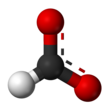Sodium formate
 | |||
| |||
| Names | |||
|---|---|---|---|
| Systematic IUPAC name
Sodium methanoate | |||
Other names
| |||
| Identifiers | |||
3D model (
JSmol ) |
|||
| ChEBI | |||
| ChEMBL | |||
| ChemSpider | |||
ECHA InfoCard
|
100.004.990 | ||
| EC Number |
| ||
| E number | E237 (preservatives) | ||
PubChem CID
|
|||
| UNII | |||
CompTox Dashboard (EPA)
|
|||
| |||
SMILES
| |||
| Properties | |||
| HCOONa | |||
| Molar mass | 68.007 g/mol | ||
| Appearance | white granules deliquescent
| ||
| Density | 1.92 g/cm3 (20 °C) | ||
| Melting point | 253 °C (487 °F; 526 K) | ||
| Boiling point | decomposes | ||
| 43.82 g/100 mL (0 °C) 97.2 g/100 mL (20 °C) 160 g/100 mL (100 °C) | |||
| Solubility | insoluble in ether soluble in glycerol, alcohol, formic acid | ||
| Thermochemistry | |||
Heat capacity (C)
|
82.7 J/mol K | ||
Std molar
entropy (S⦵298) |
103.8 J/mol K | ||
Std enthalpy of (ΔfH⦵298)formation |
−666.5 kJ/mol | ||
Gibbs free energy (ΔfG⦵)
|
−599.9 kJ/mol | ||
| Hazards | |||
| NFPA 704 (fire diamond) | |||
Except where otherwise noted, data are given for materials in their standard state (at 25 °C [77 °F], 100 kPa).
| |||
Sodium formate, HCOONa, is the sodium salt of
Preparation
For commercial use, sodium formate is produced by absorbing carbon monoxide under pressure in solid sodium hydroxide at 130 °C and 6-8 bar pressure:[1]
- CO + NaOH → HCO2Na
Because of the low-cost and large-scale availability of formic acid by carbonylation of methanol and hydrolysis of the resulting methyl formate, sodium formate is usually prepared by neutralizing formic acid with sodium hydroxide. Sodium formate is also unavoidably formed as a by-product in the final step of the pentaerythritol synthesis and in the crossed Cannizzaro reaction of formaldehyde with the aldol reaction product trimethylol acetaldehyde [3-hydroxy-2,2-bis(hydroxymethyl)propanal].[2]
In the laboratory, sodium formate can be prepared by neutralizing formic acid with sodium carbonate. It can also be obtained by reacting chloroform with an alcoholic solution of sodium hydroxide.
- CHCl3 + 4 NaOH → HCOONa + 3 NaCl + 2 H2O
or by reacting sodium hydroxide with chloral hydrate.
- C2HCl3(OH)2 + NaOH → CHCl3 + HCOONa + H2O
The latter method is, in general, preferred to the former because the low aqueous solubility of CHCl3 makes it easier to separate out from the sodium formate solution, by fractional crystallization, than the soluble NaCl would be.
Properties
Physical properties

Sodium formate crystallizes in a
Chemical properties
On heating, sodium formate decomposes to form sodium oxalate and hydrogen.[4] The resulting sodium oxalate can be converted by further heating to sodium carbonate upon release of carbon monoxide:[5][4]
As a salt of a weak acid (formic acid) and a strong base (sodium hydroxide) sodium formate reacts in aqueous solutions basic:
A solution of formic acid and sodium formate can thus be used as a
Sodium formate is slightly water-hazardous and inhibits some species of bacteria but is degraded by others.
Uses
Sodium formate is used in several fabric dyeing and printing processes. It is also used as a
In structural biology, sodium formate can be used as a cryoprotectant for X-ray diffraction experiments on protein crystals,[6] which are typically conducted at a temperature of 100 K to reduce the effects of radiation damage.
Sodium formate plays a role in the
- Sodium formate is converted with sulfuric acid to formic acid and sodium sulfate.
The
Solid sodium formate is used as a non-corrosive agent at airports for de-icing of runways in mix with corrosion inhibitors and other additives, which rapidly penetrate solid snow and ice layers, detach them from the asphalt or concrete and melt the ice rapidly. Sodium formate was also used as a road deicer in the city of Ottawa from 1987 to 1988.[7]
The high freezing point depression e.g. in comparison to the still frequently used urea (which is effective but problematic due to eutrophication) effectively prevents the re-icing, even at temperatures below −15 °C. The thawing effect of the solid sodium formate can even be increased by moistening with aqueous potassium formate or potassium acetate solutions. The degradability of sodium formate is particularly advantageous with a chemical oxygen demand (COD) of 211 mg O2/g compared with the de-icing agents sodium acetate (740 mg O2/g) and urea with (> 2,000 mg O2/g).[8]
Saturated sodium formate solutions (as well as mixtures of other alkali metal formates such as potassium and cesium formate) are used as important drilling and stabilizing aids in gas and
See also
References
- ^ Arnold Willmes, Taschenbuch Chemische Substanzen, Harri Deutsch, Frankfurt (M.), 2007.
- ISBN 978-3-527-31540-6
- ^
- PMID 20606259
- ISBN 9780873717052 – via Google Books.
- ^ "Deicer Anti-icing Snow melting Thawing Chemicals Manufacturers". Archived from the original on 2018-08-05. Retrieved 2022-03-02.
- ^ William Benton and Jim Turner, Cabot Specialty Fluids: Cesium formate fluid succeeds in North Sea HPHT field trials (PDF; 88 kB); In: Drilling Contractor, Mai/Juni 2000.




![{\displaystyle {\ce {2HCOONa->[\Delta ]{(COO)2Na2}+H2\!\uparrow }}}](https://wikimedia.org/api/rest_v1/media/math/render/svg/0f655fb700d42dd45179a6f9ba1b54f298981f72)
![{\displaystyle {\ce {(COO)2Na2->[{} \atop >\ {\ce {290^{o}C}}]{Na2CO3}+CO\!\uparrow }}}](https://wikimedia.org/api/rest_v1/media/math/render/svg/656e79ddc9dcbfe37e82e16400c3bbddd8371b07)

